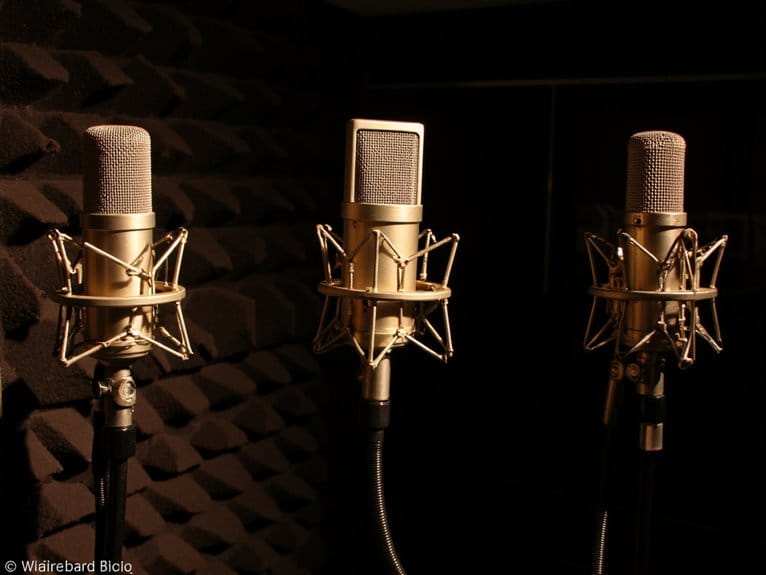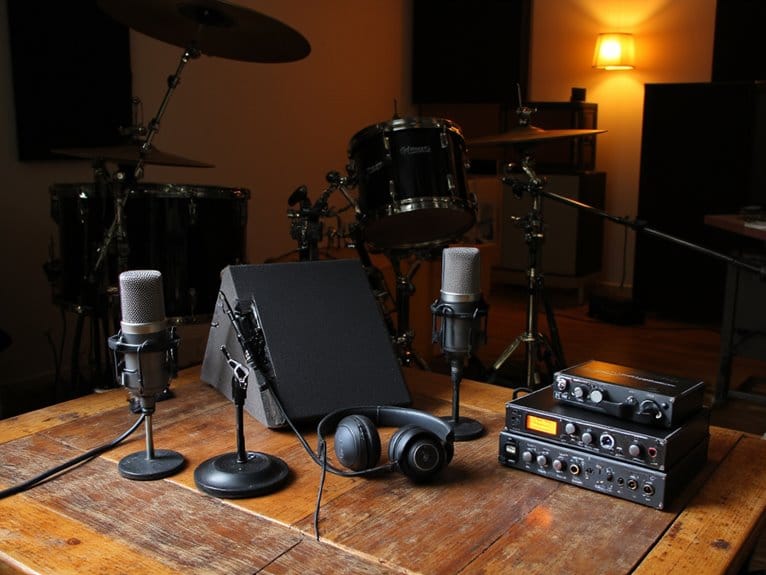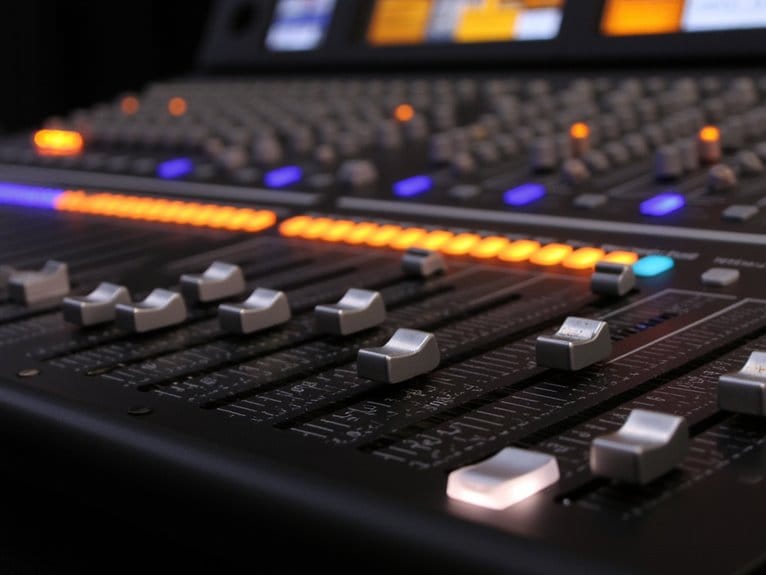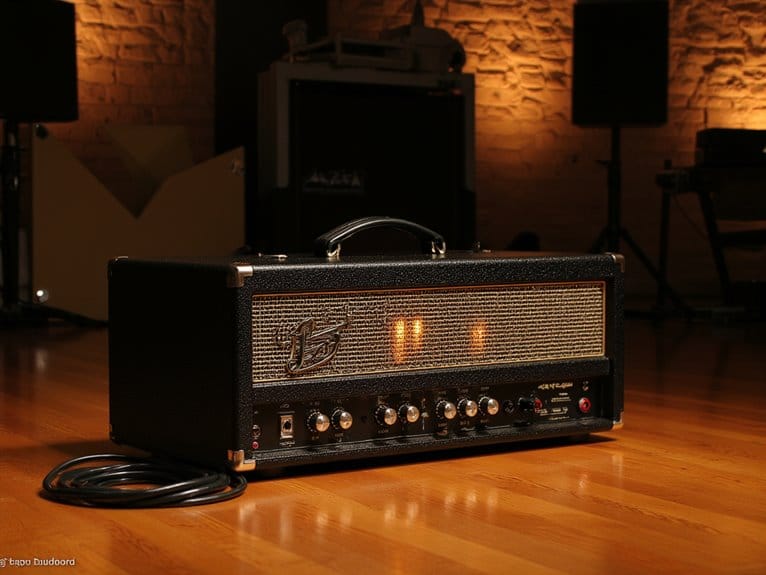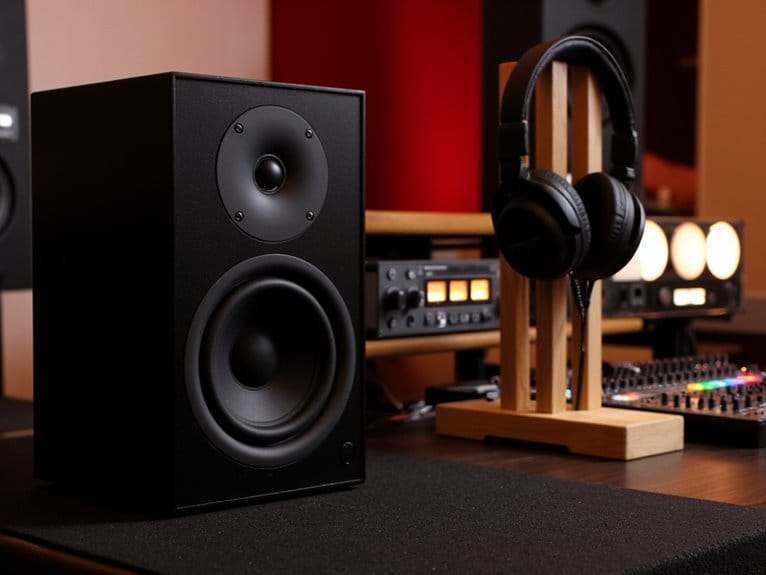Stereo Microphone Techniques: XY, ORTF, and Spaced Pair
You’ve got three essential stereo microphone techniques that’ll transform your recordings: XY uses two cardioid mics at 90-degree angles for excellent phase coherence and precise center imaging, though it creates a narrower soundstage. ORTF positions matched cardioids 17cm apart at 110° angles, balancing spaciousness with focus while maintaining mono compatibility. Spaced pairs offer maximum stereo spread but require careful phase monitoring to avoid frequency cancellations. Each technique brings distinct advantages that become vital when considering your specific recording environment and post-production goals.
We are supported by our audience. When you purchase through links on our site, we may earn an affiliate commission, at no extra cost for you. Learn more.
Notable Insights
- XY technique uses two cardioid microphones at 90° angles for excellent phase coherence and precise center imaging with narrow soundstage.
- ORTF combines spaciousness and focus using matched cardioids spaced 17cm apart at 110° angle, capturing natural 96° soundstage with good mono compatibility.
- Spaced pair technique provides maximum stereo width using microphones separated 40cm to 3 feet, ideal for orchestral recordings but requires phase monitoring.
- Phase coherence is critical for mono compatibility, with XY and coincident techniques offering excellent performance while spaced pairs require careful attention.
- Equipment requirements include frequency-matched microphones, low-noise preamps, stereo bars with precise measurements, and quality shielded cables for optimal results.
Understanding the Fundamentals of Stereo Recording
The magic of stereo recording lies in its ability to transform a flat, one-dimensional audio capture into something that mirrors how we naturally experience sound in the real world.
Stereo recording transforms flat audio into immersive soundscapes that replicate our natural three-dimensional hearing experience.
When you’re setting up microphones, you’re fundamentally recreating the sophisticated way your ears process spatial information through Interaural Time Difference and Interaural Level Difference cues.
These biological mechanisms allow you to pinpoint where sounds originate, whether it’s ambient sound from your left or a primary source directly ahead.
Stereo microphone techniques cleverly exploit these natural auditory processes by capturing level differences, time delays, or strategic combinations of both.
While this approach creates immersive three-dimensional experiences for listeners, it also introduces recording challenges like phase coherence and mono compatibility that require careful consideration during your technical setup. The X-Y technique utilizes cardioid microphones positioned at angles between 90° and 135° to capture these essential stereo differences. Professional recording standards establish that a 15 dB level difference indicates sound positioned at 30° off-center, providing a quantifiable reference for stereo image placement.
XY Technique: Close Placement for Phase Coherence
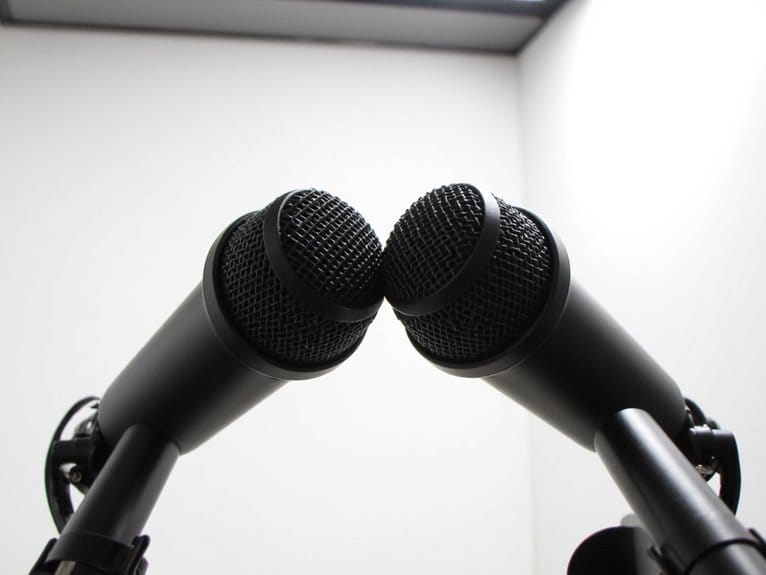
Among all stereo recording configurations, I’ve found that coincident microphone placement represents one of the most reliable approaches for maintaining phase coherence, and the XY technique stands as perhaps the most straightforward implementation of this principle.
You’ll position two cardioid condenser microphones at 90-degree angles without touching, creating close mic placements that eliminate timing differences between channels.
While the technique excels in stereo coherence and mono compatibility, you’ll notice the soundstage appears narrower than spaced configurations.
I typically place the array 6-10 feet from sources to develop adequate width, though you shouldn’t expect the immersive quality of wider techniques. The XY technique works particularly well with classical guitar recordings where the focused stereo image enhances the instrument’s natural characteristics.
The level-based imaging works particularly well for live performances where setup simplicity matters, and you can adjust angles based on your source’s width for ideal results. For optimal results, ensure your microphones capture at 24-bit/96kHz resolution to maintain the full clarity and detail that makes this technique so effective. This configuration also enhances depth perception in recordings, allowing listeners to better distinguish between foreground and background elements in the acoustic space.
ORTF Technique: Balancing Width and Focus
When you’re seeking a stereo technique that bridges the gap between the tight focus of XY and the expansive width of spaced pairs, the ORTF configuration offers an elegant solution through its precisely calibrated 110° angle and 17 cm spacing that mimics human hearing patterns.
You’ll find this French-developed approach requires matched cardioid microphones positioned according to strict technical specifications, yet it rewards your attention to detail with a stereo image that captures approximately 96° of natural soundstage while maintaining excellent mono compatibility. The cardioid polar pattern’s ability to reject off-axis sound allows you to position the microphones further from your sound sources without compromising the quality of your recording.
This configuration balances spaciousness with precise positioning accuracy, making it particularly effective when you need both spatial realism and accurate instrument placement in your recordings.
The real beauty of ORTF lies in its professional versatility, as you can deploy it confidently in everything from intimate chamber music to full orchestral recordings, knowing it’ll deliver that sweet spot between spatial width and sonic focus that keeps both audiophiles and casual listeners engaged.
Technical Setup Requirements
Setting up ORTF properly requires precise attention to specific measurements that I’ve found can make or break your stereo image. You’ll need two identical cardioid microphones positioned exactly 17 cm apart with a 110° angle between them to achieve the technique’s signature balance of width and focus.
I recommend using frequency-matched pairs like NT5s or NT55s to prevent phase issues that’ll ruin your recording. Stereo bars with ORTF markings save you the headache of measuring angles manually, though I’ve certainly fumbled with protractors before learning this lesson.
Your microphone positioning directly affects how much ambient sound you’ll capture, so consider your room acoustics carefully—closer placement reduces unwanted reflections, while backing off adds natural reverb if your space sounds good. The ORTF configuration mimics human ear placement for a more natural stereo perspective that translates well across playback systems. This near-coincident technique delivers excellent mono compatibility while maintaining the focused center image that makes recordings sound professional.
Stereo Image Characteristics
Because ORTF delivers a notably wider stereo image than XY configurations, you’ll immediately notice how this technique captures soundscapes with impressive lateral spread while maintaining that essential central focus—something I’ve come to appreciate after years of comparing different stereo approaches.
The 110-degree microphone angle, combined with precise 17-centimeter spacing, creates sophisticated stereo imaging techniques that balance width with remarkable mono compatibility.
Your recordings will exhibit enhanced depth perception through strategic positioning considerations:
- Cardioid rejection patterns minimize off-axis ambient noise while preserving directional accuracy
- Interaural spacing mimicry naturally enhances stereo separation without sacrificing central clarity
- Room reverberation capture adds dimensional depth when microphones are positioned appropriately
- Frequency response consistency maintains tonal balance across the entire stereo field
This careful balance prevents the stereo image from becoming unfocused while delivering that coveted wide soundstage characteristic. The ORTF configuration excels at capturing natural ambient sounds with remarkable fidelity and spatial accuracy.
The technique demonstrates optimal performance at close distances, making it particularly effective for intimate recording scenarios where precise stereo definition is paramount.
Professional Application Benefits
While mastering various stereo techniques over the years, I’ve discovered that ORTF‘s professional application benefits extend far beyond its technical specifications—this approach delivers consistent, repeatable results that meet broadcast standards while offering the creative flexibility that studio engineers and field recording professionals demand.
In professional applications, you’ll find ORTF particularly valuable for its mono compatibility, which translates seamlessly across diverse playback systems without phase cancellation issues that plague other techniques.
For sound reinforcement work, the cardioid patterns reject unwanted ambient noise while maintaining natural spatial imaging, making it ideal for live concert recordings where controlled room pickup is essential.
The technique’s broadcast-ready characteristics guarantee your recordings meet industry standards while preserving the artistic integrity that separates professional work from amateur attempts.
Spaced Pair Technique: Maximum Stereo Spread
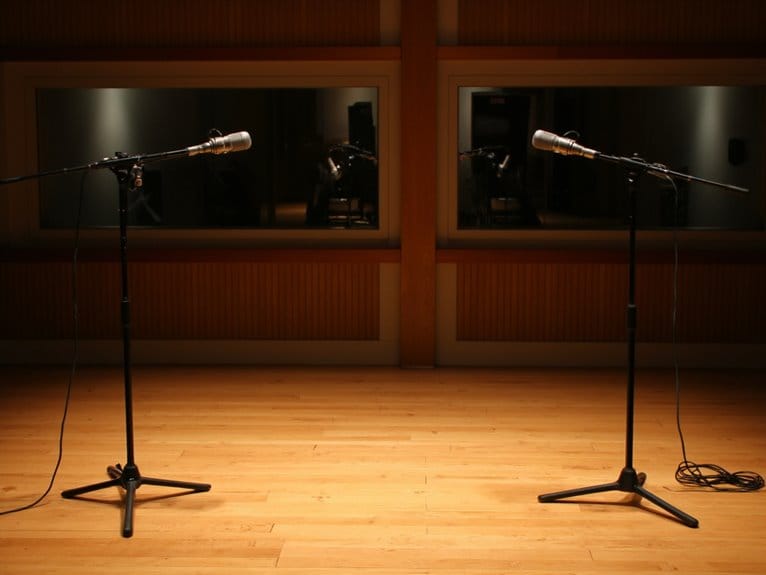
A concert hall’s expansive soundstage represents the holy grail of stereo recording, and the spaced pair technique delivers exactly that kind of maximum stereo spread that makes listeners feel like they’re sitting in the sweet spot of Carnegie Hall.
You’ll position two microphones parallel, separated by 40 cm to 3 feet, depending on your recording environments and specific microphone characteristics you’re working with.
This technique excels at capturing spacious orchestral recordings, though you’ll need to monitor phase coherence carefully:
- Distance ratio: Maintain 3:1 spacing between mics relative to source distance
- Optimal spacing: 40-60 cm for natural tonal reproduction with omni mics
- Phase monitoring: Check mono compatibility during setup to avoid frequency cancellations
- Strategic positioning: Place mics equidistant from central source elements
Equipment Requirements and Microphone Selection
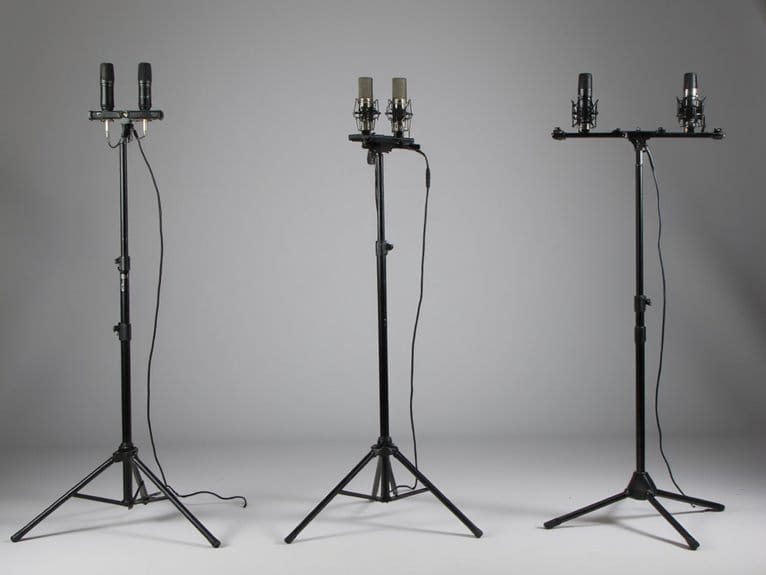
Once you’ve identified the ideal stereo technique for your space and project, your success hinges entirely on selecting microphones that’ll actually deliver the sonic characteristics you’re chasing.
Microphone specifications matter notably more in stereo recording than most people realize, since frequency response mismatches between your pair will create an unbalanced, unprofessional image that’ll haunt your mix.
Equipment compatibility becomes essential when you’re investing in condenser microphones, which typically demand phantom power from your preamp, mixer, or dedicated supply.
I’ve learned that matching sensitivity ratings prevents one microphone from overpowering the other during recording.
Professional stereo recording requires maintaining self-noise ratings below 20 dB to ensure clarity between channels without interference.
Essential equipment requirements include:
- Stereo bars for precise angular positioning and spacing control
- Shock mounts to eliminate mechanical vibrations and handling noise
- Low-noise preamps that maintain signal clarity throughout the recording chain
- Quality cables with proper shielding to preserve signal integrity
Consider polar pattern type carefully when selecting your microphone pair, as cardioid patterns help minimize interference between channels while maintaining proper stereo imaging.
Phase Coherence and Mono Compatibility Considerations
When you’re setting up stereo microphone arrays, you’ll need to understand how phase relationships between your left and right channels affect both the stereo image and what happens when someone plays your recording in mono.
I’ve learned through countless sessions that even perfectly positioned microphones can create phase cancellation issues that’ll make your carefully crafted stereo mix sound hollow, thin, or completely lose certain frequency ranges when summed to mono.
You can avoid these problems by analyzing phase relationships during recording and testing mono compatibility throughout your mixing process, which I’ll show you saves significant time compared to discovering phase issues after you’ve already committed to a particular microphone technique.
Phase Relationship Analysis
Most engineers I’ve encountered over the years underestimate how dramatically phase relationships can make or break their stereo recordings, yet it’s arguably the fundamental element that determines whether your carefully planned microphone setup delivers professional results or becomes a frustrating mix nightmare.
When you’re analyzing phase alignment between your stereo pair, you’ll notice that even tiny timing discrepancies create significant frequency response issues. XY configurations naturally minimize these problems, while spaced pairs demand constant vigilance against comb filtering artifacts that’ll hollow out your mix.
- Use phase meters during tracking to identify problematic frequency cancellations before they reach your DAW
- Check mono compatibility by summing your stereo channels and listening for dramatic tonal shifts
- Watch for low-frequency phase issues that create muddy bass response in wider microphone spacings
- Monitor real-time correlation meters to maintain ideal phase coherence throughout your recording session
Mono Compatibility Testing
Phase coherence analysis becomes particularly critical when you consider that many of your listeners won’t experience your carefully crafted stereo image in its intended form, making mono compatibility testing an indispensable step in your recording workflow. Your DAW’s mono switch becomes your best friend here, revealing phase cancellation effects that’ll make you cringe when you hear how your beautiful recording transforms into a hollow, filtered mess.
| Technique | Mono Compatibility | Phase Issues |
|---|---|---|
| XY | Excellent | Minimal timing differences |
| ORTF | Good | Small spatial delays |
| Spaced Pair | Poor to Fair | Significant phase shifts |
| Coincident | Excellent | Near-zero phase variance |
Conducting thorough mono compatibility analysis involves repeatedly toggling between stereo and mono while listening for frequency cancellations, particularly in the midrange frequencies where phase interactions become most audible and problematic.
Frequently Asked Questions
Can I Combine Different Stereo Techniques in the Same Recording Session?
You can absolutely create hybrid recordings by combining different stereo techniques in one session, and I’ve found technique blending offers remarkable flexibility during post-production.
You’ll capture multiple spatial perspectives simultaneously, though you’ll need to monitor phase relationships carefully between setups.
While this approach requires more microphones and channels, it gives you various stereo images to choose from when mixing.
How Do Room Acoustics Affect the Performance of Each Technique?
Room reflections dramatically impact your recording quality depending on which technique you’re using, and I’ve learned this the hard way in countless studio sessions.
XY techniques handle poor acoustics well since coincident placement minimizes phase issues from reflections, while spaced pairs become problematic in reverberant rooms, often producing muddy frequency response and unstable imaging that’ll frustrate your mixing process later.
Are There Specific Wind Protection Requirements for Outdoor Stereo Recording?
You’ll need matched windshield types for both microphones to maintain stereo imaging integrity in outdoor environments.
I’ve found that foam-plus-fur deadcats work well for moderate winds, while professional zeppelin systems with furry covers handle severe conditions without disrupting XY or ORTF placement geometry.
Always use symmetrical protection on both mics, test your setup beforehand, and consider shock mounts since wind can create mechanical vibrations that’ll ruin your recordings.
On a final note
You’ve now explored three fundamental stereo recording approaches, each offering distinct sonic characteristics and practical applications. XY provides tight phase coherence, ORTF delivers balanced width with natural imaging, and spaced pairs create expansive soundstages with enhanced ambience. Your choice depends on your recording environment, source material, and creative vision. Remember that proper placement, careful monitoring, and understanding each technique’s strengths will consistently yield professional results in your stereo recordings.

